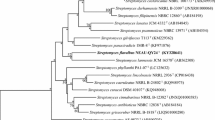Abstract
An unknown yeast species was isolated from maize silage and was determined to be novel on the basis of morphological and physiological characteristics, nucleotide sequence of domain D1/D2 of LSU rDNA and from its electrophoretic karyotype. The name for the proposed new species is Saccharomyces bulderi Middelhoven, Kurtzman et Vaughan-Martini (type strain CBS 8638, NRRL Y-27203, DBVPG 7127). S. bulderi is closely related to S. barnettii and S. exiguus from which it can be distinguished by having a double vitamin requirement of biotin and thiamine and by no or slow aerobic growth on raffinose, a sugar that on the contrary is fermented rapidly. Gluconolactone is rapidly fermented with ethanol, glycerol and carbon dioxide being the main products.
Similar content being viewed by others
References
Bulder CJEA (1963) On respiratory deficiency in yeasts. PhD Thesis, Delft
Bulder CJEA (1964) Lethality of the petite mutation in petite negative yeasts. Antonie van Leeuwenhoek 30: 442–454
Bulder CJEA (1966) Lethality in respiratory deficiency and utilization of fermentation energy in petite negative yeasts. Arch f Mikrobiol. 53: 189–194
Kluyver AJ (1914) Biochemische suikerbepalingen. PhD Thesis, Delft
Kurtzman CP & Robnett CJ (1998) Identification and phylogeny of ascomycetous yeasts from analysis of nuclear large subunit (26S) ribosomal DNA partial sequences. Antonie van Leeuwenhoek 73: 331–371
Marmur J & Doty P (1962) Determination of the base composition of desoxyribonucleic acid from its thermal denaturation temperature. J Mol Biol. 5: 109–118
Middelhoven WJ (1997) Assimilation of organic acids: the pH as determining factor. YEAST, a newsletter for persons interested in yeast 46(II): 19–20
Middelhoven WJ & Franzen MM (1986) The yeast flora of ensiled whole-crop maize. J Sci Food Agric. 37: 855–861
Vaughan-Martini A (1995) Saccharomyces barnetti and Saccharomyces spencerorum: two new species of Saccharomyces sensu lato (van der Walt). Antonie van Leeuwenhoek 68: 111–118
Vaughan-Martini A & Martini A (1998) Saccharomyces Meyen ex Reess. In: Kurtzman CP & Fell JW (Eds) The Yeasts, a taxonomic study, 4th edn. (pp 358–371). Elsevier, Amsterdam
van derWalt JP & Yarrow D (1984) Methods for the isolation, maintenance, classification and identification of yeasts. In: Kreger-van Rij NJW (Ed) The Yeasts, a taxonomic study, 3rd edn. (pp 45–104). Elsevier Science Publishers, Amsterdam
van Hoek P, van Dijken JP & Pronk JT (1998) Effect of specific growth rate on fermentative capacity of baker's yeast. Appl Environm Microbiol. 64: 4226–4233
Author information
Authors and Affiliations
Corresponding author
Rights and permissions
About this article
Cite this article
Middelhoven, W.J., Kurtzman, C.P. & Vaughan-Martini, A. Saccharomyces bulderi sp. nov., a yeast that ferments gluconolactone. Antonie Van Leeuwenhoek 77, 223–228 (2000). https://doi.org/10.1023/A:1002414301967
Issue Date:
DOI: https://doi.org/10.1023/A:1002414301967




